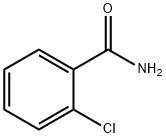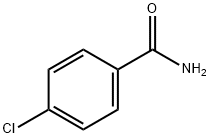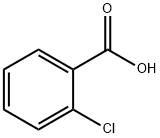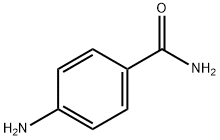2-Chlorobenzamide
- CAS NO.:609-66-5
- Empirical Formula: C7H6ClNO
- Molecular Weight: 155.58
- MDL number: MFCD00007973
- EINECS: 210-195-6
- SAFETY DATA SHEET (SDS)
- Update Date: 2024-08-21 22:41:43

What is 2-Chlorobenzamide?
Chemical properties
The substance is an almost white crystalline powder that can be dissolved in solvents such as benzene and toluene.
The Uses of 2-Chlorobenzamide
2-Chlorobenzamide is used to synthesize chlortetracycline and o-chlorobenzoyl isocyanate, which is an intermediate in chlortetracycline synthesis.
General Description
2-Chlorobenzamide is the major degradation product of CCU (1-(2-chlorobenzoyl)-3-(4-chlorophenyl) urea), a new insect growth regulator. It undergoes room temperature Pd-mediated hydrodehalogenations with KF and polymethylhydrosiloxane (PMHS) to yield benzamide. t undergoes reduction with NaBH4 in diglyme at 162°C to yield 2-chlorobenzonitrile.
Synthesis
Prepared by reacting o-chlorobenzoyl chloride with ammonia.
Properties of 2-Chlorobenzamide
| Melting point: | 142-144 °C(lit.) |
| Boiling point: | 275.0±23.0 °C(Predicted) |
| Density | 1.2187 (rough estimate) |
| refractive index | 1.5618 (estimate) |
| storage temp. | Sealed in dry,Room Temperature |
| pka | 15.36±0.50(Predicted) |
| form | powder to crystal |
| color | White to Almost white |
| BRN | 508510 |
| CAS DataBase Reference | 609-66-5(CAS DataBase Reference) |
| EPA Substance Registry System | 2-Chlorobenzamide (609-66-5) |
Safety information for 2-Chlorobenzamide
| Signal word | Warning |
| Pictogram(s) |
 Skull and Crossbones Acute Toxicity GHS06  Exclamation Mark Irritant GHS07 |
| GHS Hazard Statements |
H302:Acute toxicity,oral H315:Skin corrosion/irritation H319:Serious eye damage/eye irritation H330:Acute toxicity,inhalation H335:Specific target organ toxicity, single exposure;Respiratory tract irritation |
| Precautionary Statement Codes |
P264:Wash hands thoroughly after handling. P264:Wash skin thouroughly after handling. P270:Do not eat, drink or smoke when using this product. P280:Wear protective gloves/protective clothing/eye protection/face protection. P320:Specific treatment is urgent (see … on this label). P330:Rinse mouth. P304+P340:IF INHALED: Remove victim to fresh air and Keep at rest in a position comfortable for breathing. P305+P351+P338:IF IN EYES: Rinse cautiously with water for several minutes. Remove contact lenses, if present and easy to do. Continuerinsing. P405:Store locked up. P501:Dispose of contents/container to..… |
Computed Descriptors for 2-Chlorobenzamide
Abamectin manufacturer
New Products
4-AMINO-TETRAHYDRO-PYRAN-4-CARBOXYLIC ACID HCL 4-(Dimethylamino)tetrahydro-2H-pyran-4-carbonitrile 4-Aminotetrahydropyran-4-carbonitrile Hydrochloride (R)-3-Aminobutanenitrile Hydrochloride 3-((Dimethylamino)methyl)-5-methylhexan-2-one oxalate 1,4-Dioxa-8-azaspiro[4.5]decane 5-Bromo-2-nitropyridine Nimesulide BP Aceclofenac IP/BP/EP Diclofenac Sodium IP/BP/EP/USP Mefenamic Acid IP/BP/EP/USP Ornidazole IP Diclofenac Potassium THOMAIND PAPER PH 2.0 TO 4.5 1 BOX BUFFER CAPSULE PH 9.2 - 10 CAP SODIUM CHLORIDE 0.1N CVS ALLOXAN MONOHYDRATE 98% PLATINUM 0.5% ON 3 MM ALUMINA PELLETS (TYPE 73) LITHIUM AAS SOLUTION 2-Bromo-1-(bromomethyl)-3-chloro-5-nitrobenzene 2-Bromo-3-nitroaniline N-(3-Hydroxypropyl)-N-methylacetamide 3-Bromo-6-chloropyridazine 4-ethyl-3-nitrobenzoic acidRelated products of tetrahydrofuran








You may like
-
 609-66-5 2-Chlorobenzamide 98%View Details
609-66-5 2-Chlorobenzamide 98%View Details
609-66-5 -
 609-66-5 98%View Details
609-66-5 98%View Details
609-66-5 -
 2-Chlorobenzamide CAS 609-66-5View Details
2-Chlorobenzamide CAS 609-66-5View Details
609-66-5 -
 1823368-42-8 98%View Details
1823368-42-8 98%View Details
1823368-42-8 -
 2-(3-(tert-butyl)phenoxy)-2-methylpropanoic acid 1307449-08-6 98%View Details
2-(3-(tert-butyl)phenoxy)-2-methylpropanoic acid 1307449-08-6 98%View Details
1307449-08-6 -
 Ethyl 3-(furan-2-yl)-3-hydroxypropanoate 25408-95-1 98%View Details
Ethyl 3-(furan-2-yl)-3-hydroxypropanoate 25408-95-1 98%View Details
25408-95-1 -
 2-Chloro-5-fluoro-1-methoxy-3-methylbenzene 98%View Details
2-Chloro-5-fluoro-1-methoxy-3-methylbenzene 98%View Details
1805639-70-6 -
 Lithium ClavulanateView Details
Lithium ClavulanateView Details
61177-44-4
Statement: All products displayed on this website are only used for non medical purposes such as industrial applications or scientific research, and cannot be used for clinical diagnosis or treatment of humans or animals. They are not medicinal or edible.